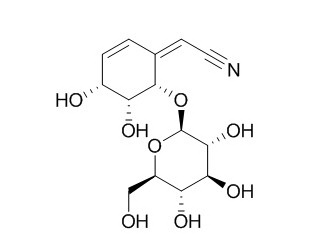5-Epilithospermoside
(-)-5-Epilithospermoside is proposed as a potential marker of botanical origin for phacelia honey.
Inquire / Order:
manager@chemfaces.com
Technical Inquiries:
service@chemfaces.com
Tel:
+86-27-84237783
Fax:
+86-27-84254680
Address:
1 Building, No. 83, CheCheng Rd., Wuhan Economic and Technological Development Zone, Wuhan, Hubei 430056, PRC
Providing storage is as stated on the product vial and the vial is kept tightly sealed, the product can be stored for up to
24 months(2-8C).
Wherever possible, you should prepare and use solutions on the same day. However, if you need to make up stock solutions in advance, we recommend that you store the solution as aliquots in tightly sealed vials at -20C. Generally, these will be useable for up to two weeks. Before use, and prior to opening the vial we recommend that you allow your product to equilibrate to room temperature for at least 1 hour.
Need more advice on solubility, usage and handling? Please email to: service@chemfaces.com
The packaging of the product may have turned upside down during transportation, resulting in the natural compounds adhering to the neck or cap of the vial. take the vial out of its packaging and gently shake to let the compounds fall to the bottom of the vial. for liquid products, centrifuge at 200-500 RPM to gather the liquid at the bottom of the vial. try to avoid loss or contamination during handling.
Journal of Third Military Medical University2019, 41(2):110-115
Vet World.2023, 16(3):618-630.
Chemistry of Natural Compounds2018, 54(3):572-576
Hum Exp Toxicol.2017, 36(11):1169-1176
Cosmetics2025, 12(3), 108
Research Square2021, March 3rd.
Int J Mol Sci.2022, 23(21):12816.
Plant Growth Regulation2020, 90(2):383-392
Food Chem.2019, 274:345-350
J of Food Quality2020, 8851285.
Related and Featured Products
Food Chemistry, 2018, 255:332-339.
Nitrogen compounds in Phacelia tanacetifolia Benth. honey: First time report on occurrence of (-)-5-epi-lithospermoside, uridine, adenine and xanthine in honey.[Reference:
WebLink]
METHODS AND RESULTS:
Lacy phacelia (Phacelia tanacetifolia Borkh.) honey composition was screened by UHPLC-DAD-QqTOF-MS. The targeted analysis revealed 6 major nitrogen compounds including aromatic amino acids (tyrosine, phenylalanine), purine derivatives (adenine, xanthine), nucleoside (uridine) and rare non-cyanogenic cyanoglucoside, (-)-5-epi-lithospermoside ((2Z)-2-[(4R,5R,6S)-4,5-dihydroxy-6-(β-d-glucopyranosyl)oxycyclohex-2-en-1-ylidene]acetonitrile). Their identity was confirmed by different analytical tools: HRMS, co-chromatography with standard compound or comprehensive NMR experiments. All the compounds, except amino acids, were reported and determined in honey for the first time. The amount of the compounds was quantified in 16 unifloral phacelia samples: adenine (18.45 ± 4.63 mg/kg), xanthine (10.53 ± 2.98 mg/kg), uridine (42.84 ± 9.26 mg/kg), tyrosine (14.66 ± 10.22 mg/kg), (-)-5-epi-lithospermoside (70.61 ± 31.37 mg/kg) and phenylalanine (20.41 ± 11.99 mg/kg).
CONCLUSIONS:
The (-)-5-Epilithospermoside content is significantly correlated with P. tanacetifolia pollen percentage (R2 = 0.5612, p < 0.001) and it is proposed as a potential marker of botanical origin for phacelia honey.



